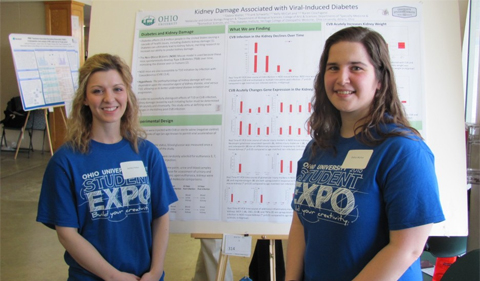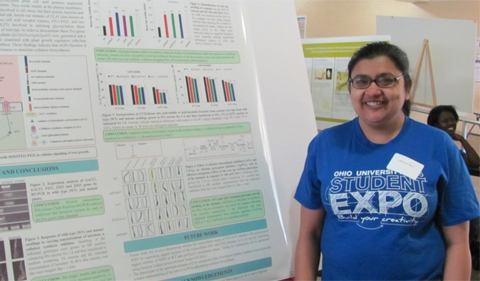Molecular and Cellular Biology students took several top science prizes at the 2015 Ohio University Student Research & Creative Activity EXPO, held at the Convocation Center on April 9. The expo featured more than 800 student participants.
Ashley Patton, 1st place (Diabetes Institute 2), second place (Biological Sciences G1) for Small Molecule Inflammatory Inhibitors Prevent the Early Development of High Fat Diet-Induced Non-alcoholic Fatty Liver Disease
Debra Walter, second place (Diabetes Institute 2) for Kidney Damage Associated with Viral-Induced Diabetes’
Xuan Wang, first place (Biological Sciences G2)
Reetobrata Basu, first place (Biomedical Sciences G1) for Restoration of Extracellular Bicarbonate of Cystic Fibrosis Pulmonary Epithelium Modulates Innate Immunomodulatory Pathways
Abstract: Cystic fibrosis is caused by a deficit of bicarbonate (HCO3–) secretion due to a dysfunctional CF transmembrane conductance regulator (CFTR) protein leading to a chronic inflammatory state mediated by the Toll-like receptor (TLR) signaling pathway leading to tissue degeneration. Our study observed significant modulations of TLR expressions in response to LPS treatment , on correction of bicarbonate levels in the CaLu3-CFTR-knockout model, indicating a possible simple therapeutic approach.
Mark Slayton, first place (Biomedical Sciences G2) for Human Cytomegalovirus DNA Replication is Regulated by Viral Protein UL34
Abstract: Human cytomegalovirus (HCMV) is an important opportunistic pathogen in humans. HCMV has a large genome, encoding 176 genes; of these, 50 genes are required for viral replication. One of the essential genes, the UL34 gene, encodes a sequence-specific DNA-binding protein which binds to a 10 base pair nucleotide element comprised of AAACACCGT[T/G] (a UL34 binding site). The UL34 binding site occurs 14 times within the viral genome with three of the UL34 binding sites located near the origin of lytic replication (oriLyt). The presence of the UL34 binding sites in this region suggested that UL34 contributes to the efficiency of oriLyt-dependent viral DNA replication. We introduced mutations in the binding sites and examined the resultant effect on viral DNA replication. Our results demonstrate that UL34-DNA interactions near the oriLyt are required for DNA replication.
Debarati Basu, J first place ( Sigma Xi2) for Arabinogalactan-proteins function in cellular signaling of root growth by stimulating cellulose biosynthesis in Arabidopsis
Abstract: Arabinogalactan-proteins (AGPs) are highly glycosylated plant cell wall proteins expressed ubiquitously in all plant cells from algae to angiosperms. They reside mainly at the plasma membrane-cell wall interface and in plant exudates. AGPs are involved in salt stress, but their precise function and mode of action isunclear . In the presence of elevated salt, knock-out mutants of FLA4 (also known as SOS5), a fasciclin-like arabinogalactan-protein, two cell wall receptor kinases, FEI1/FEI2, and two AGP-specific galactosyltransferases (GALT2/GALT5) involved in initiating glycosylation share identical phenotypes i.e., abnormal radial swelling of root tips. In order to demonstrate these five genes act in a single genetic pathway, quintuple mutant plants (fei1fei2sos5galt2galt5) were generated and a potential signaling pathway involving AGPs was examined with plant growth regulators (ethylene inhibitors) and isoxaben, a cellulose synthesis inhibitor. These findings indicate that AGPs function in root growth by interacting with cell wall receptor kinases to stimulate cellulose biosynthesis.
Amrita Basu and co. Reetobrata Basu, J first place (Diabetes Institute 1) for Behavioral, Genomic and Proteomic Analysis of Wild Type vs. Growth Hormone Modified (bGH and GHA) Mice: Spatial Learning, Memory and Signaling Crosstalk
Abstract: The study aimed at analyzing changes in learning and behavior, gene expression and protein levels in the brain of mice with a modified growth hormone signaling (increased by bGH and reduced in GHA). Our study demonstrates reduced learning and gene expression profile in mice with GH hyperactivity and upregulated gene expression with better memory performance in mice with reduced growth hormone signaling status.





















Comments